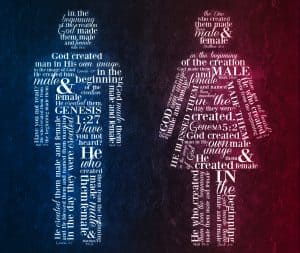What God Said About Humanity and Marriage at Creation Is True for All Time
If you believe in what it says in Genesis 1 about God making heaven and earth—and the binaries in Genesis are so important—heaven and earth, and sea and dry land, and so on, and you end up with male and female. It’s all about God making complementary pairs, which are meant to work together. The last scene in the Bible is the new heaven and the new earth and…the marriage of Christ and his church. It’s not just one or two verses here and there which say this or that. It’s an entire narrative which works with this complementarity, so that a male-plus-female marriage is a signpost or a signal about the goodness of the original creation and God’s intention for the eventual new heavens and new earth.
—N. T. Wright1—
View summaries of all the articles in this series here.
Key point: When God created the earth at the dawn of time, He soon thereafter created humanity male and female—and in so doing He established marriage as the first institution.
Last time, we began examining several elements in the exchange between Jesus and the Pharisees in Matthew 19:1-8. “Is it lawful,” the Pharisees asked, “for a man to divorce his wife for just any reason?” Jesus’ reply is very instructive for the church with regard to the true meaning of marriage, one of the hot button issues of our day. You can read the passage in its context, along with the parallel passage in Mark’s Gospel, here. Matthew 19:4-6 records Jesus’ response to the Pharisees.
4 And He answered and said to them, “Have you not read that He who made them at the beginning ‘made them male and female,’ 5 and said, ‘For this reason a man shall leave his father and mother and be joined to his wife, and the two shall become one flesh’? 6 So then, they are no longer two but one flesh. Therefore what God has joined together, let not man separate.”
Haven’t You Read?
What elements in this passage are especially noteworthy and helpful for us? First, initially, Jesus answered with a question. He essentially asked the Jewish leaders, “Haven’t you read the Genesis account of the creation of humanity and the establishment of marriage as the first institution?” We rightly can call this an account (rather than accounts) because in creating humanity as male and female, God simultaneously established the institution of marriage (more on this in a moment). Here is our discussion of the phrase “Have you not read…?”
Back to Genesis
 Second, it is noteworthy that Jesus quotes Genesis in His answer. He combines Genesis 1:27 and 5:2 with Genesis 2:24. You can read all three of these verses in context, along with Jesus’ words as recorded in Matthew and Mark here. We will focus on Matthew’s account of Jesus’ quotation.
Second, it is noteworthy that Jesus quotes Genesis in His answer. He combines Genesis 1:27 and 5:2 with Genesis 2:24. You can read all three of these verses in context, along with Jesus’ words as recorded in Matthew and Mark here. We will focus on Matthew’s account of Jesus’ quotation.
- Genesis 1:27 in its entirety reads, 27 “So God created man in His ownimage; in the image of God He created him; male and female He created them.”
- Genesis 5:2 says, “He created them male and female, and blessed them and called them Mankind in the day they were created.”
- Genesis 2:24 says, “Therefore a man shall leave his father and mother and be joined to his wife, and they shall become one flesh.”
Again, Jesus responded to the Pharisees by saying this. (We have underlined the quoted portions.)
“Have you not read that He who made them at the beginning ‘made them male and female,’ [Gen. 1:27 and 5:2] 5 and said, ‘For this reason a man shall leave his father and mother and be joined to his wife, and the two shall become one flesh’ [Gen. 2:24]? 6 So then, they are no longer two but one flesh. Therefore what God has joined together, let not man separate” (Matt. 19:4-6).
Note that Jesus quoted from the earliest words recorded in the first book of the Bible. Jesus was referring to the Hebrew Scriptures, but Genesis also is the first book in Orthodox, Catholic, and Protestant Bibles as well. Not every book in the Bible is chronically arranged, but the placement of Genesis first is indeed chronologically correct. Certainly the earliest chapters of the book reflect the earliest events of recorded history.
The Pharisees believed the Old Testament to be inspired by God. They emphasized the importance of obeying the it as well as oral traditions. They went “by the Book.” Thus, if the Pharisees were familiar with any portion of the Old Testament, they certainly should have been familiar with the statements Jesus quoted.
I want to be clear. I am not accusing evangelical leaders of being Pharisaical in the sense of having prideful attitudes. Still, I must point out that we also ought to be familiar with the Old Testament words Jesus quoted. Moreover, we ought to understand their meaning and significance.
From the Beginning
 Third, Jesus explicitly said “He who made them at the beginning ‘made them male and female” (emphasis added). The fact that to be human means, inherently, to be either male or female is a truth as old as time itself. In creating humanity as male and female, God effectively established marriage as an institution. Indeed, as we read further in Genesis, and as we continue to read Jesus’ statements in Matthew 19, this is exactly what we will find.
Third, Jesus explicitly said “He who made them at the beginning ‘made them male and female” (emphasis added). The fact that to be human means, inherently, to be either male or female is a truth as old as time itself. In creating humanity as male and female, God effectively established marriage as an institution. Indeed, as we read further in Genesis, and as we continue to read Jesus’ statements in Matthew 19, this is exactly what we will find.
It is entirely appropriate, therefore, that the authors of the Pledge in Solidarity to Defend Marriage would emphasize the foundational nature of humanity as male and female in the pledge’s opening paragraphs.
We stand together in defense of marriage and the family and society founded upon them. While we come from a variety of communities and hold differing faith perspectives, we are united in our common affirmation of marriage.
On the matter of marriage, we stand in solidarity. We affirm that marriage and family have been inscribed by the Divine Architect into the order of Creation. Marriage is ontologically between one man and one woman, ordered toward the union of the spouses, open to children and formative of family. Family is the first vital cell of society, the first government, and the first mediating institution of our social order. The future of a free and healthy society passes through marriage and the family.
Marriage as existing solely between one man and one woman precedes civil government. Though affirmed, fulfilled, and elevated by faith, the truth that marriage can exist only between one man and one woman is not based on religion or revelation alone, but on the Natural Law, written on the human heart and discernible through the exercise of reason. It is part of the natural created order. The Natural Law is what Dr. Martin Luther King, Jr., referred to as a higher law or a just law in his famous Letter from Birmingham Jail.
Marriage is the preeminent and the most fundamental of all human social institutions. Civil institutions do not create marriage nor can they manufacture a right to marry for those who are incapable of marriage. Society begins with marriage and the family.
We pledge to stand together to defend marriage for what it is, a bond between one man and one woman, intended for life, and open to the gift of children.
We see, then, that the meaning of marriage as a commitment of one man and one woman arises naturally from the fact that human beings have been created and exist as male and female individuals. This is the created order, and it was, as Jesus said, at—and thus it has been since—the beginning.
“For this Reason”
Fourth, Jesus’ use of the phrase “for this reason” is extremely important. Read again the background passages along with Jesus’ response to the Pharisees here. For your convenience, we present once more Jesus’ reply to the Pharisees as recorded in Matthew 19:4-6, with the portions Jesus quoted from the Old Testament underlined.
Have you not read that He who made them at the beginning “made them male and female,” [Gen. 1:27 and 5:2] 5 and said, “For this reason a man shall leave his father and mother and be joined to his wife, and the two shall become one flesh” [Gen. 2:24]? 6 So then, they are no longer two but one flesh. Therefore what God has joined together, let not man separate.
It is entirely fitting for Jesus to place Genesis 1:27 and 5:2 alongside Genesis 2:24, even though the prepositional phrase “For this reason” [which comes from Gen. 2:24] clearly refers to what came before it originally, the statements immediately prior to it in Genesis 2. Here are those statements, along with verses 24 and 25.
18 And the Lord God said, “It is not good that man should be alone; I will make him a helper comparable to him.” 19 Out of the ground the Lord God formed every beast of the field and every bird of the air, and brought them to Adam to see what he would call them. And whatever Adam called each living creature, that was its name. 20 So Adam gave names to all cattle, to the birds of the air, and to every beast of the field. But for Adam there was not found a helper comparable to him.
Adam in the garden of Eden, as depicted at the Creation Museum
21 And the Lord God caused a deep sleep to fall on Adam, and he slept; and He took one of his ribs, and closed up the flesh in its place. 22 Then the rib which the Lord God had taken from man He made into a woman, and He brought her to the man.
23 And Adam said:
“This is now bone of my bones
And flesh of my flesh;
She shall be called Woman,
Because she was taken out of Man.”
24 Therefore a man shall leave his father and mother and be joined to his wife, and they shall become one flesh.
25 And they were both naked, the man and his wife, and were not ashamed (Gen. 2:18-25).
Made for Each Other
Essentially, Jesus summarized Genesis 2:18-23 with these words, the bolded portion of which comes from Genesis 1:27 and 5:2: “He who made them at the beginning ‘made them male and female’” (Matt. 19:4). This is exactly what Genesis 2:18-23 tells us!
For what reason, then, shall a man “leave his father and mother and be joined to his wife, and the two shall become one flesh” (Gen. 2:24; Matt. 19:5; Mark 10:6-8)? The answer is clear. It first is stated in Genesis and then restated by Jesus in Matthew and Mark: Because God created human beings as male and female! Bible scholar William Hendriksen puts it this way: In Genesis 2:24,
God ordains that for this very reason—that is, because the union between the two was intended to be so intimate and they were designed for each other (see both Gen. 1:27 and 2:23)—a man shall leave his father and his mother, and shall do this with a view to a more intimate and more lasting attachment, namely, “and shall cleave to his wife, and the two shall be one flesh”; yes, “no longer two but one flesh,” says Jesus2 [emphasis added].
Why shall a man leave his father and mother and be joined to his wife, and the two become one flesh? Because God created human beings as male and female!
A man and a woman are alike in that each is human; yet each is different from the other in both obvious and subtle ways. Significantly, God said, “It is not good that man should be alone; I will make him a helper comparable to him” (Gen. 2:18). Because a man and a woman are different, they are compatible. I don’t mean that any man is compatible with any woman in the same way we think of relational compatibility for a specific couple. I mean generally speaking, the differences between men and women make a man and woman suitable for each other in a marriage relationship.
 Male-female differences enhance curiosity, augment relational chemistry, and intensify attraction between two members of the opposite sex. We can sense at least some of these elements in Edmund Leighton’s painting Courtship. Go here to see additional works by Leighton that showcase the healthy tension and even mystery unique to opposite-sex relationships.
Male-female differences enhance curiosity, augment relational chemistry, and intensify attraction between two members of the opposite sex. We can sense at least some of these elements in Edmund Leighton’s painting Courtship. Go here to see additional works by Leighton that showcase the healthy tension and even mystery unique to opposite-sex relationships.
Male-female differences also set the stage for a husband and wife to be an effective team, not only in ways that benefit each other, but also in ways that meet the needs of any children born as a result of their union. Yes, these differences can be a source of great frustration as well, but as a couple works through the obstacles together, their bond becomes stronger, deeper, and more intimate. We do not have any of this with same-sex couples.
We now have considered four elements of Jesus’ exchange with the Pharisees in Matthew 19. We have several more to explore. Hang tight! We hope next time to get to all the rest.
Part 3 is available here.
Copyright © 2017 by B. Nathaniel Sullivan. All rights reserved.
Unless otherwise indicated, Scripture has been taken from the New King James Version®. Copyright © 1982 by Thomas Nelson, Inc. Used by permission. All rights reserved.
Notes:
1N. T. Wright, as quoted in Ray Ortlund, Marriage and the Mystery of the Gospel, (Wheaton, IL: Crossway, 2016), 27-28. N. T. Wright’s statements are available online here.
2William Hendriksen, The Gospel of Matthew, (Grand Rapids: Baker Book House, 1973), 715.
image credits: all images with the exceptions of the NASA image and the Defend Marriage logo: www.lightstock.com



